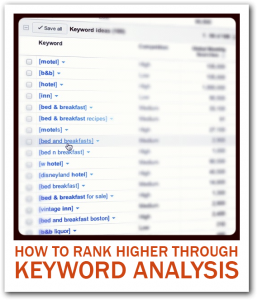 A keyword analysis (or keyword research) is the art and science of uncovering which keyword phrases your prospects are likely to use at Google or other search engines.
A keyword analysis (or keyword research) is the art and science of uncovering which keyword phrases your prospects are likely to use at Google or other search engines.
Why is this important?
Because search engines are looking to return relevant results when someone performs a search. The closer the words on your web page, blog post or online video are to the search that was just performed, the more likely you are to rank higher for that search.
Higher rankings mean more qualified traffic. In fact, a recent study showed that the number one result averaged a 36.4% click through rate (CTR.) The second place result only managed 12.1% CTR, and the CTR declined with every subsequent result.
Although using the right keywords isn’t the only reason why your page ranks well or poorly–the quality and quantity of inbound links is important, too–it’s one of the easiest variables for you to affect.
How do you perform a keyword analysis?
Keyword research is a three step process:
- Brainstorm: Whether by yourself, with team members, or trusted customers and clients, you should start by brainstorming a list of your best keywords. These would be the words you think your ideal customer would use when searching for a product or service like yours, or phrases you’d like to rank well for. Anything from “Boston tax accountant” to “how do I write off a business expense?” I talk about using five perspectives to generate the best keyword phrases.
- Test: After you generate your keywords, you’ll want to determine if they actually will bring you enough traffic. Often, we’ve been in our industry for so long we use jargon that our prospects don’t use. Or, we are missing out on new, related phrases that could attract new customers. Using a tool like Google Adwords Keyword Tool will help you determine which words and phrases are most likely to attract the most qualified traffic. By entering your phrases into this free online tool, you can discover how much competition you would have from other sites to rank well for a phrase, as well as how many people are actually searching for that phrase. In addition, GAKT will provide a lot of related phrases that may perform better than your original list.
- Rewrite: Once you have your list of your best keywords, get to work putting them in strategic places on each page of your site, including the page title, any headers or subheaders, early and often in the body copy, as well as in the intrasite links from one page to another.
How do you know if it’s working?
Improved search engine visibility rarely happens overnight. Continually adding new, keyword rich content to your blog or website over time will improve your search engine ranking and attract more qualified traffic to your site.
Two reports in Google Analytics can help determine if this is happening. The first can be found at Traffic Sources > Search Engine Optimization > Queries. This report shows your site’s average ranking for any keyword that “resulted in impressions, clicks and click-throughs.” You can see if you’re moving up or down over time.
The second report can be found at Traffic Sources > Search Engine Optimization > Landing Pages. This will show you how your individual pages are fairing from a search engine standpoint.
Finally, take a look at your overall search traffic and the number of leads you’re generating from your website. If the number of leads you’re getting a month is increasing, your work is making a difference.